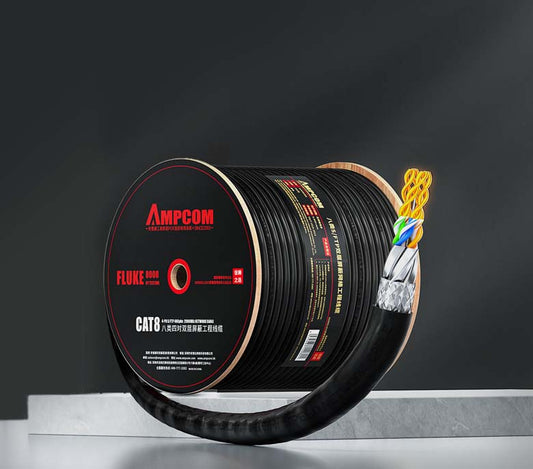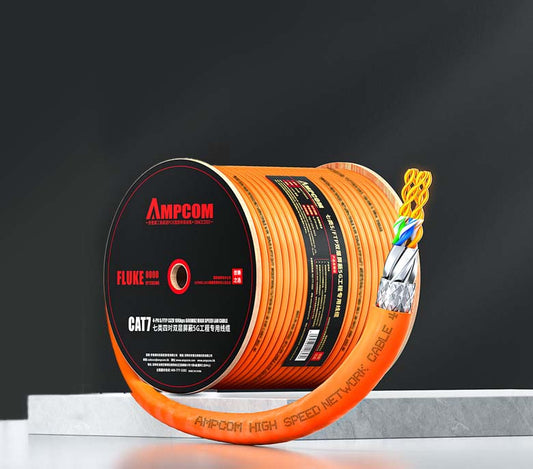اتصال مستقبلي: كابلات شبكة Cat6a تُرسي الأساس لشبكة 10G في كل مكان
عندما احتاجت شبكة إيثرنت 10 جيجابت (10GBASE-T) لاجتياز قناة 100 متر كاملةً بكفاءة، لبت كابلات الفئة 6A (المعززة) النداء. وبموجب معايير ISO/IEC 11801 التعديل 2 و TIA/EIA-568-C.2-1 ، لم تكن Cat6a مجرد ترقية تدريجية، بل كانت نقلة نوعية صُممت للتغلب على قيود الأجيال السابقة. ويضمن تطبيق هذه المعايير الصارمة توفير Cat6a اتصالاً ثابتًا وعالي الأداء عبر كامل المسافة القياسية.
كابل توصيل AMPCOM Cat6a 28AWG UTP، فائق النحافة، LSZH، للكابلات الهيكلية وأسلاك أنظمة المراقبة
أداء لا مثيل له: كابلات شبكة Cat7 تُنشئ قناة بيانات عالية الدقة من البداية إلى النهاية
أكثر من مجرد توجيه كابلات شبكة الجيجابت: تنفيذ معيار Cat6 الدولي يمهد الطريق لشبكات 10G
فهم إجماع كابلات الشبكة العالمية: معيار Cat5e الدولي يُحدد عصر "الكفاية"

المعايير الرئيسية للأداء الكامل لمسافة 100 متر و10 جيجا
تقدم معايير Cat6a تحسينات حاسمة:
- التردد: يتضاعف مرة أخرى إلى 500 ميجا هرتز، مما يوفر النطاق الترددي المطلوب لـ 10 جيجابايت على مسافات أطول.
- السرعة والمسافة: الميزة المميزة: الدعم الموحد لشبكة إيثرنت بسرعة 10 جيجابت في الثانية (10GBASE-T) عبر قناة كاملة بطول 100 متر، من لوحة التوصيل إلى لوحة التوصيل.
- تحسين التحكم في التداخل: تفرض المعايير حدودًا أكثر صرامةً لـ NEXT وPSNEXT وACR (نسبة التوهين إلى التداخل) وخسارة الارتداد مقارنةً بـ Cat6. يُعد هذا أمرًا بالغ الأهمية للحفاظ على سلامة الإشارة عند تردد 500 ميجاهرتز على طول الرابط. غالبًا ما تتميز كابلات Cat6a بتصميم مادي مُحسّن، مثل معدلات لف زوجية أكثر ثباتًا أو حتى فاصل مادي (وإن كان أقل شيوعًا من Cat7)، لتلبية هذه المتطلبات الصارمة.
- تخفيف محسّن: تضمن حدود التخفيف المنخفضة بقاء قوة الإشارة كافية عند الترددات الأعلى وعلى مسافة 100 متر كاملة.
- قدرة معدات توفير الطاقة (PSE): غالبًا ما تتضمن معايير Cat6a أيضًا متطلبات لدعم معايير PoE (الطاقة عبر Ethernet) ذات الطاقة الأعلى مثل PoE+ (802.3at) ومستويات طاقة أعلى (على سبيل المثال، 90 وات لـ 802.3bt)، مما يجعلها مثالية لتشغيل كاميرات IP ونقاط الوصول اللاسلكية وأجهزة PoE الأخرى.
يتم التحقق من الامتثال لهذه المعايير من خلال بروتوكولات اختبار صارمة، مما يضمن التوافق وتناسق الأداء عبر منتجات البائعين المختلفين على مستوى العالم.

حيث تتفوق Cat6a: البيئات عالية الطلب
إن الأداء الموحد الكامل 10G لـ Cat6a يجعله المعيار الفعلي للعديد من التركيبات الحديثة:
- مراكز البيانات: للاتصالات بين الخادم والمحول والمحول إلى المحول حيث تكون النطاق الترددي العالي والموثوقية أمرًا بالغ الأهمية.
- شبكات المؤسسة الأساسية: دعم بيئات المكاتب الكبيرة، وربط الخزائن، وتوفير وصول عالي السرعة إلى نقاط النهاية.
- المباني الذكية: دعم العدد المتزايد من الأجهزة المتصلة وأجهزة الاستشعار وأنظمة التحكم التي تتطلب اتصالات موثوقة وعالية النطاق الترددي.
- مناطق Wi-Fi عالية الكثافة: تمكين نقاط الوصول عالية الأداء من خدمة عدد كبير من المستخدمين في وقت واحد.
- مرافق الرعاية الصحية: دعم الأجهزة الطبية الحيوية ومعدات التصوير عالية الدقة وقدرات الرعاية الصحية عن بعد القوية.

تطبيق واقعي: مركز البيانات الحديث
كانت شركة "Quantum Data Systems" تُشيّد مركز بيانات حوسبة جديدًا عالي الأداء. كان مطلبهم واضحًا: يجب أن يكون كل خادم متصلًا بسرعة 10 جيجابت في الثانية، وأن تكون الشبكة مواكبة للمستقبل على الأقل للعقد القادم. تم استبعاد Cat5e وCat6 نظرًا لقيودهما التي تصل إلى 10 جيجابت في الثانية على 100 متر.
حدد مديرو المشروع كابلات Cat6a، ملتزمين تمامًا بمعيار TIA/EIA-568-C.2-1. هذا يعني استخدام مكونات Cat6a معتمدة (كابلات، لوحات توصيل، موصلات) وضمان تقنيات تركيب سليمة، بما في ذلك التوصيل والاختبار الصحيحين وفقًا لمتطلبات المعيار. سمحت لهم مواصفات التداخل والتوهين الأكثر صرامة، التي يفرضها المعيار، بنشر 10GBASE-T بثقة في جميع أنحاء المنشأة، بدءًا من المفاتيح الأساسية الموجودة في أعماق رفوف الخوادم ووصولًا إلى طبقة التوزيع.
كانت النتيجة شبكةً استوفت معايير الأداء المطلوبة فورًا، ووفرت مساحةً كافيةً للنمو المستقبلي، كالانتقال إلى سرعات 25/40 جيجابت في الثانية، أو حتى 100 جيجابت في الثانية (غالبًا عبر مكونات بصرية نشطة) دون الحاجة إلى إعادة توصيل كابلات البنية التحتية النحاسية. وقد وفّر تطبيق معيار Cat6a أساسًا للموثوقية والأداء اللازمين للعمليات التجارية الحيوية في مركز البيانات.
بفضل تطبيقها الدقيق لمعاييرها الدولية، رسّخت Cat6a شبكة إيثرنت بسرعة 10 جيجابت كواقعٍ موثوقٍ عبر قناة كاملة بطول 100 متر. ولا تزال هذه الشبكة رائدةً في مجال كابلات النحاس عالية الأداء في البيئات المتطلبة، مما يضمن اتصالاً يواكب عالمنا الذي يزداد استهلاكاً للبيانات.



